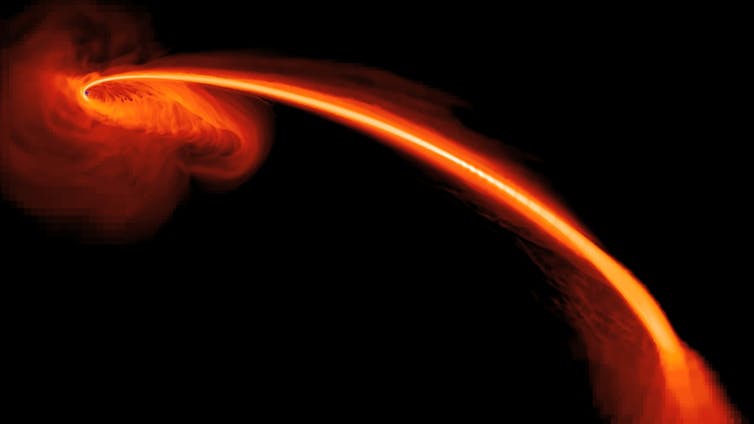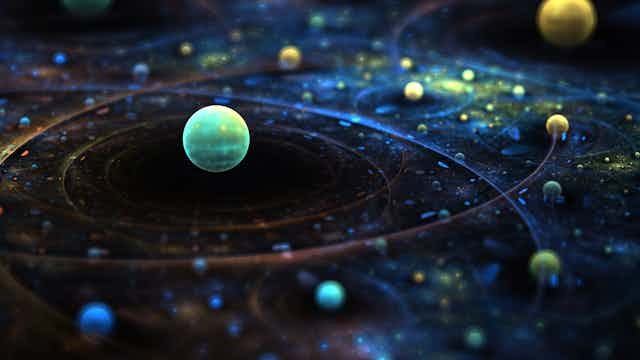One hundred years ago this month, an obscure German physicist named Albert Einstein presented to the Prussian Academy of Science his General Theory of Relativity. Nothing prior had prepared scientists for such a radical re-envisioning of the foundations of reality.
Encoded in a set of neat compact equations was the idea that our universe is constructed from a sort of magical mesh, now known as “spacetime”. According to the theory, the structure of this mesh would be revealed in the bending of light around distant stars.
To everyone at the time, this seemed implausible, for physicists had long known that light travels in straight lines. Yet in 1919 observations of a solar eclipse revealed that on a cosmic scale light does bend, and overnight Einstein became a superstar.
Einstein is said to have reacted nonchalantly to the news that his theory had been verified. When asked how he’d have reacted if it hadn’t been, he replied: “I would have felt sorry for the dear Lord. The theory is correct.”
What made him so secure in this judgement was the extreme elegance of his equations: how could something so beautiful not be right?
The quantum theorist Paul Dirac would latter sum up this attitude to physics when he borrowed from poet John Keats, declaring that, vis-à-vis our mathematical descriptions of nature, “beauty is truth, and truth beauty”.
Art of science
A quest for beauty has been a part of the tradition of physics throughout its history. And in this sense, general relativity is the culmination of a specific set of aesthetic concerns. Symmetry, harmony, a sense of unity and wholeness, these are some of the ideals general relativity formalises. Where quantum theory is a jumpy jazzy mash-up, general relativity is a stately waltz.
As we celebrate its centenary, we can applaud the theory not only as a visionary piece of science but also as an artistic triumph.
What do we mean by the word “art”?
Lots of answers have been proposed to this question and many more will be given. A provocative response comes from the poet-painter Merrily Harpur, who has noted that “the duty of artists everywhere is to enchant the conceptual landscape”. Rather than identifying art with any material methods or practices, Harpur allies it with a sociological outcome. Artists, she says, contribute something bewitching to our mental experience.
It may not be the duty of scientists to enchant our conceptual landscape, yet that is one of the goals science can achieve; and no scientific idea has been more enrapturing than Einstein’s. Though he advised there’d never be more than 12 people who’d understand his theory, as with many conceptual artworks, you don’t have to understand all of relativity to be moved by it.

In essence the theory gives us a new understanding of gravity, one that is preternaturally strange. According to general relativity, planets and stars sit within, or withon, a kind of cosmic fabric – spacetime – which is often illustrated by an analogy to a trampoline.
Imagine a bowling ball sitting on a trampoline; it makes a depression on the surface. Relativity says this is what a planet or star does to the web of spacetime. Only you have to think of the surface as having four dimensions rather than two.
Now applying the concept of spacetime to the whole cosmos, and taking into account the gravitational affect of all the stars and galaxies within it, physicists can use Einstein’s equations to determine the structure of the universe itself. It gives us a blueprint of our cosmic architecture.
Synthesis
Einstein began his contemplations with what he called gedunken (or thought) experiments; “what if?” scenarios that opened out his thinking in wildly new directions. He praised the value of such intellective play in his famous comment that “imagination is more important than knowledge”.
The quote continues with an adage many artists might endorse: “Knowledge is finite, imagination encircles the world.”
But imagination alone wouldn’t have produced a set of equations whose accuracy has now been verified to many orders of magnitude, and which today keeps GPS satellites accurate. Thus Einstein also drew upon another wellspring of creative power: mathematics.
As it happened, mathematicians had been developing formidable techniques for describing non-Euclidean surfaces, and Einstein realised he could apply these tools to physical space. Using Riemannian geometry, he developed a description of the world in which spacetime becomes a dynamic membrane, bending, curving and flexing like a vast organism.
Where the Newtonian cosmos was a static featureless void, the Einsteinian universe is a landscape, constantly in flux, riven by titanic forces and populated by monsters. Among them: pulsars shooting out giant jets of x-rays and light-eating black holes, where inside the maw of an “event horizon”, the fabric of spacetime is ripped apart.
One mark of an important artist is the degree to which he or she stimulates other creative thinkers. General relativity has been woven into the DNA of science fiction, giving us the warp drives of Star Trek, the wormhole in Carl Sagan’s Contact, and countless other narrative marvels. Novels, plays, and a Philip Glass symphony have riffed on its themes.
At a time when there is increasing desire to bridge the worlds of art and science, general relativity reminds us there is artistry in science.
Creative leaps here are driven both by playful speculation and by the ludic powers of logic. As the 19th century mathematician John Playfair remarked in response to the bizzarities of non-Euclidean geometry, “we become aware how much further reason may sometimes go than imagination may dare to follow”.
In general relativity, reason and imagination combine to synthesise a whole that neither alone could achieve.

